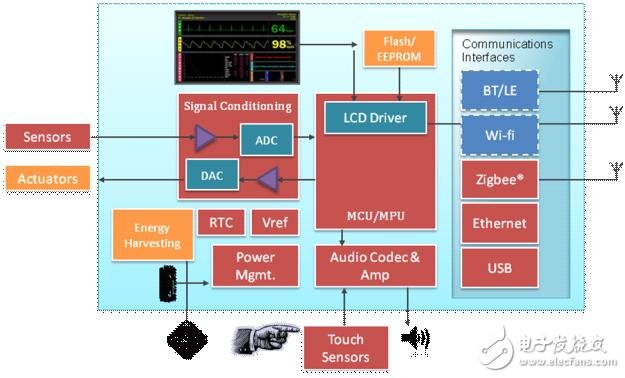Electronic enthusiasts : Semiconductor technology is driving smarter, more accurate, and more connected next-generation medical devices. What semiconductor technology is creating conditions for future medical devices? David Niewolny of Freescale Semiconductor discusses the evolution of semiconductor technology that has the greatest impact on medical device design.
The healthcare industry is undergoing a technological revolution. The global population ageing and rising healthcare costs have put the health care infrastructure around the world in a state of tension. The baby boom generation has now become a senior population, which has exacerbated the growth of the elderly population. To cope with this dramatic demographic transition, health systems need to change dramatically. These changes now include new treatments and early diagnostic tools that can only be achieved through advanced hardware and software technologies that have long been unused because the medical device industry is avoiding risks. So, what technology is creating conditions for future medical devices?

Figure 1: Standard medical device architecture
Figure 1 shows a typical standard hardware architecture for medical devices. The evolution of chip technology that drives innovation in medical device design is listed below.
· Analog signal conditioning
· Low power embedded control
· Wireless connections
Chip vendors offer significant technological advancements in these strategic areas, which are necessary for medical device customers to optimize their products.
One of the important and unique features of medical devices is the ability to analyze very small data signals captured by wired or wireless sensors. Precision analog components such as op amps, high-resolution analog-to-digital converters (ADCs), digital-to-analog converters (DACs), analog comparators (ACMP), and voltage references (VREF) are evolving and evolving to improve next-generation medical devices Accuracy creates conditions.
An op amp is used to amplify and filter the signal, and an analog comparator (ACMP) can be configured to trigger an interrupt when it reaches a peak. The next stage requires a precisely timed sensor attenuation output analog-to-digital converter. Device designers should look for analog-to-digital converters (ADCs) that are feature-rich, ultra-low-power, and higher than 16-bit resolution. ADCs with up to 24-bit resolution are available for very precise measurements. Many newer ADCs have automatic comparisons and flexible conversion time settings, making them ideal for this type of analysis. Finally, the data is sent to the CPU (8-bit or 32-bit) for analysis of the math part.
While the chip can be turned on or off with analog circuitry, the on-chip integration of analog functions offers many system cost advantages. The most obvious advantage is that it reduces the need for external ICs, saving BOM and board space. In addition, the on-chip analog has low-voltage detection and an internal bandgap reference voltage, further reducing overall cost.
Another aspect is to reduce power consumption, and semiconductor design will have a major impact on the healthcare industry every step of the way. Low power consumption makes devices that were originally constrained by power consumption portable, and then turns portable solutions into wireless sensors. For many medical devices, a microcontroller or microprocessor is a core component that performs most application tasks even without performing all application tasks. Microcontrollers may be a major contributor to reducing device power consumption, so the microcontroller's capabilities must be utilized to achieve battery life goals. Whether it's beaming in standby mode or taking measurements, these features affect the life of the battery and determine the value of a product to the end customer.
Semiconductor manufacturers are taking steps to reduce the operating power of medical devices by implementing some innovative design techniques. The first is to implement an additional mode of operation. Each low power mode is tailored to the specific level of functionality for the best performance/power ratio. For some devices, the operating mode supports a minimum power consumption of 250 nA, which allows medical applications to run continuously with maximum energy efficiency. The Run mode also enables many MCU peripherals to operate in a low power mode of operation for optimal combination of functions and power.
Protection systems
Over voltage and over current protection components that satisfies all safety requirements of modern telecommunication systems. We offer single pair protection plug and Protection Magazine 10pair for your option.
What's more,we can also provide you the STB Module(05 point,03point),3M Single Line Splitter and Bridging Module.Welcom to purchase from us.We will give you the best price.

Protection For Telecommunication
STB Module, Protection Terminal Block, LSA Protection Plug, 3Pole Magazine For LSA Module, Ericsson Protector Magazine, Integrated Protector, Protection Magazine, Terminal Block, Terminal Block Connector
NINGBO YULIANG TELECOM MUNICATIONS EQUIPMENT CO.,LTD. , https://www.yltelecom.com